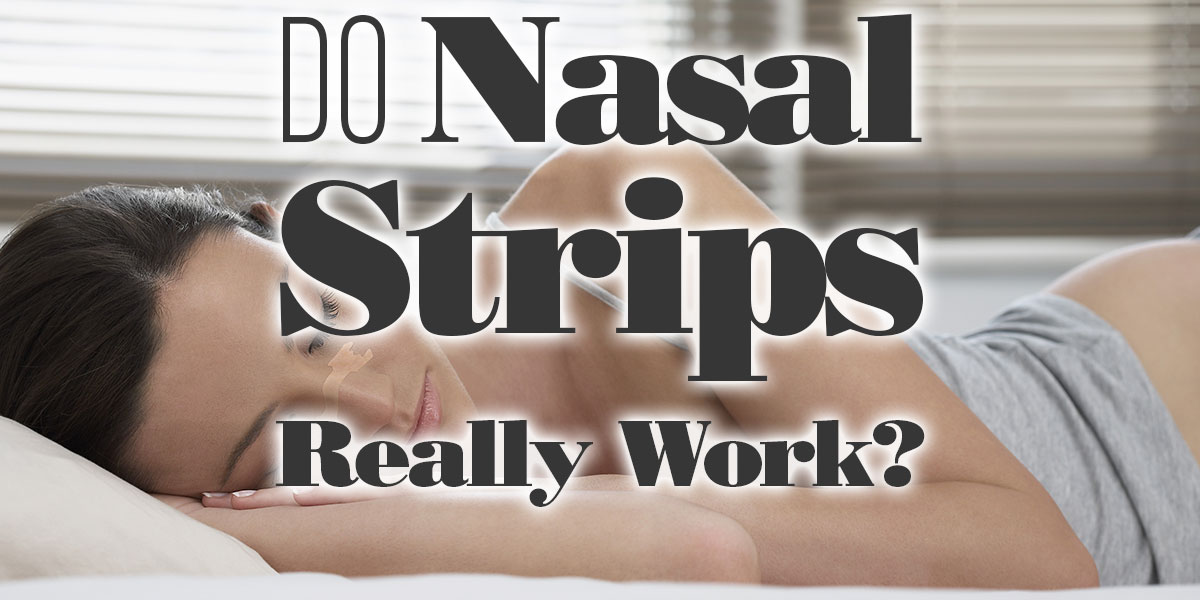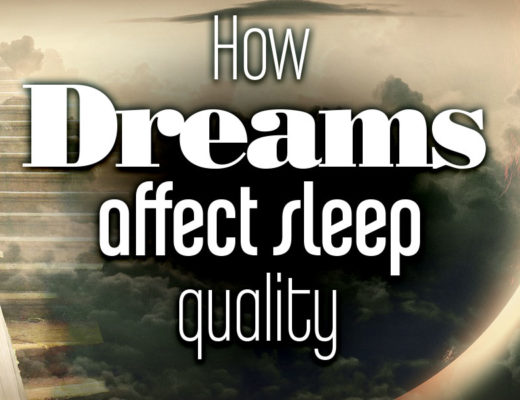Snoring may begin as a minor nuisance, but it has the potential to have a long-lasting negative impact on your health if left unchecked. Some effective treatments can address snoring at the root of the issue, ranging from machines to surgery, but these can be expensive. Before you take that extraordinary step, you should try a simpler solution first: nasal strips.
Do nasal strips really help reduce snoring? The answer is yes, but not if the cause of snoring is a separate breathing condition, like sleep apnea. Simple obstructions like narrowed nasal passages are easily relieved with nasal strips, however.
If you or your partner snore, you already know how it can weaken the quality of sleep and keep you up at night. To illustrate exactly how nasal strips work to treat snoring, we’ll first explore what causes the problem in the first place. We’ll then discuss how exactly nasal strips work and what they can (and can’t) help with. Finally, we’ll provide advice for using nasal strips.
What Causes Snoring?
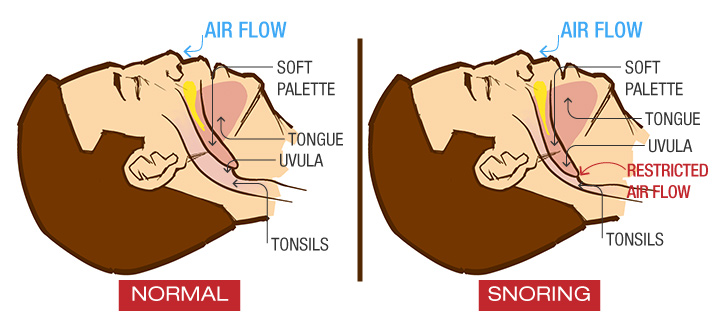 We all know what snoring sounds like, but do you know what causes it? On the surface, it’s simple: tissues in your throat vibrate, causing the loud sawing noise we’re all familiar with (and loathe). These vibrations are caused by obstruction or blockage in the nasal passages, reducing airflow. This could be the result of many different issues, including narrow nasal passages, congestion or other illness, enlarged tonsils and adenoids, allergic reactions (common when using old pillows), deviated septum, and nasal polyps.
We all know what snoring sounds like, but do you know what causes it? On the surface, it’s simple: tissues in your throat vibrate, causing the loud sawing noise we’re all familiar with (and loathe). These vibrations are caused by obstruction or blockage in the nasal passages, reducing airflow. This could be the result of many different issues, including narrow nasal passages, congestion or other illness, enlarged tonsils and adenoids, allergic reactions (common when using old pillows), deviated septum, and nasal polyps.
In some cases, snoring may not be the result of a medical condition but rather how you choose to sleep. If you sleep on your back, the position can cause the base of your tongue to stick to the back of your throat, obstructing airflow. Alternatively, your head may need more elevation from pillows to keep airways sufficiently open.
Weight gain can be a culprit but isn’t always the source of snoring in new patients. Putting on a few more pounds around your abdomen won’t influence how you breathe, but extra weight on your neck can constrict your throat. With less room for air to flow through, vibrations occur.
As the underlying cause of these problems is poor breathing. The first solution should be to increase airflow through the nose and throat. There is prescription and over the counter medications that are designed to do just that, but these shouldn’t be taken without direction from your primary care doctor. Before you make that call (or while you’re waiting for that appointment), you may want to give nasal strips a try.
How Do Nasal Strips Work?
Nasal strips are part of a range of treatments called nasal dilators. They work by widening the passages in your nose so that you can get more air when you breathe and minimize the effect of obstructions. Other nasal dilators are taken internal as pills or a spray, but the nasal strips are applied externally.
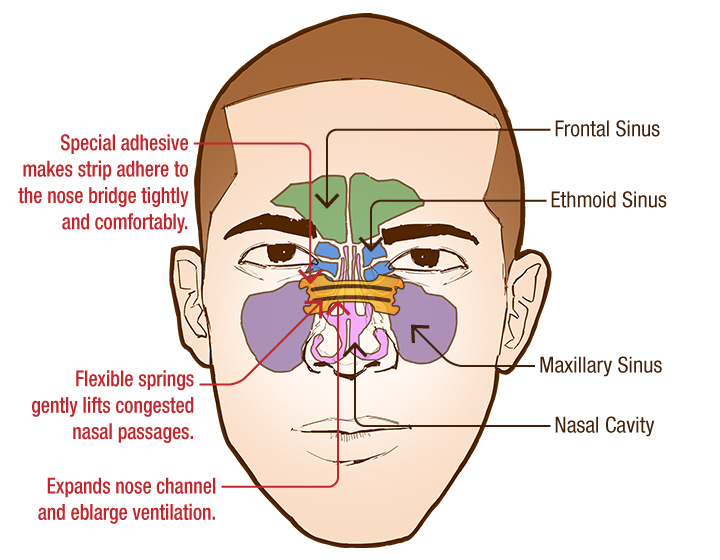 Looking something like a bandage but feeling stiffer, a nasal strip adheres to the bridge of the nose and the sides/tops of the nostrils. Splints inside of the strip then pull away gently, holding the nostrils open and widening the nose’s airways. They are designed for single-use and a new one needs to be applied each night. Their use as a sleep aid isn’t intended to cure the root cause of your snoring; if you stop using them after a time the problem will most likely resume.
Looking something like a bandage but feeling stiffer, a nasal strip adheres to the bridge of the nose and the sides/tops of the nostrils. Splints inside of the strip then pull away gently, holding the nostrils open and widening the nose’s airways. They are designed for single-use and a new one needs to be applied each night. Their use as a sleep aid isn’t intended to cure the root cause of your snoring; if you stop using them after a time the problem will most likely resume.
When properly applied, nasal strips are engineered to open the first three centimeters of your nasal passages wider, facilitating better airflow when breathing. This means that it’s better for certain types of obstructions than others. Congestion that’s further back in your nose, for example, will likely go unaffected by the use of nasal strips. It’s also an ineffective way to treat sleep apnea.
How Can I Tell If Nasal Strips Could Work For Me?
If you’re unsure if nasal strips will help improve your situation, the British Snoring and Sleep Apnea Association has devised a simple test (found here) to help you identify if your snoring is nasal related. To perform it, simply press one nostril closed with the tip of your finger and breathe in through the other, with your mouth closed. If the other nostril closes in on itself, try to hold it open with something narrow and try again. If it remains open this way, its a strong indicator that whatever obstruction your dealing with can be helped with nasal strips.
Are There Any Dangers To Nasal Strips?
On their own, nasal strips are risk-free and pose no immediate dangers. The only side effect reported is irritation caused by the adhesives used (either in removing them or as a reaction to something in the adhesives themselves—this may be an allergic reaction to the chemical used in specific brands). Long term use has shown neither harm in patients nor decrease in overall effectiveness, and in fact, long term use is recommended. Nasal strips are relatively inexpensive and available over the counter, so this shouldn’t be a problem.
However, if the cause of your snoring is sleep apnea and you don’t know it; or if you try to use nasal strips to treat it, know that you are potentially putting yourself in danger. Sleep apnea is a condition like snoring but much more severe; the sudden collapse of airways can cause you to wake up gasping for air. The list of medical complications that can arise from this is quite long and includes problems with memory and focus, irritability, low energy levels, and increased risk of heart attack, hypertension, stroke, diabetes, and other fatal conditions.
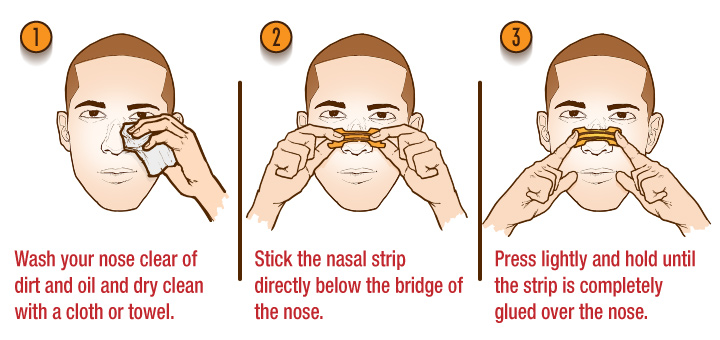
Given how dire it can be, how could someone confuse sleep apnea with regular snoring? For starters, they sound pretty similar, though sleep apnea is louder. Sleep apnea can cause you to startle awake multiple times a night; though rare, the same can happen with snoring.
That’s why it’s important to address the fact that nasal strips have never been shown to help treat sleep apnea in any way in a medical study. If you’re unsure of what the source of your snoring is; it’s best to check with your primary care physician before you decided to try a remedy on your own. If it’s something serious like sleep apnea, you’ll need specific professional care.
How Effective Are They?
Confusion abounds in the general public over whether or not nasal strips work to treat snoring; which is understandable: while the strips themselves are pretty simple; how they work and what they treat is where the issue gets murky. Muddying up the waters is the number of studies done by the medical community highlighting different results. Stranger still is the uses people have found for them that don’t relate to sleep.
Swedish study
First, let’s look at some of the studies that have been performed. This Swedish study looked specifically at Breathe Right brand nasal strips (arguably the most popular brand, though other options are available). After conducting tests to remove patients with sleep apnea, thirty-five patients diagnosed as “habitual snorers” used the strips for fourteen consecutive nights. The study notes a “statistically significant decreases in snoring” and recommends them for that purpose.
However, this study tells a different story while still focusing on Breathe Right strips. These participants had “chronic nocturnal nasal congestion.” The results found that their symptoms did not improve, nor did their quality of sleep.
When you’re looking at this evidence, you’ll quickly find that different studies, appear to contradict each other. However, medical studies (including sleep studies) tend to be very specific in demonstrating results. This includes potential variables in patients, like chronic congestion or other conditions. If you know yourself and the full extent of your circumstances; you’ll have a much easier time sifting through the results to find what’s relevant to you.
Other uses for nasal strips have called their overall effectiveness into question; even when the alternative uses have nothing to do with sleep. If you watch American football, you’ve probably noticed that players sometimes wear nasal strips while they play. The idea behind this is that it will allow them to breathe easier and reduce shortness of breath. However, studies have yet to prove that this works to enhance athletic performance, hence why some people claim any effect they have is a placebo.
Again, studies that have been performed specifically focusing on the ability of nasal strips to reduce snoring provide ample evidence that they do work for this intended function. Just because an alternative use isn’t a reason to disregard them entirely.
What If I Snore Through My Mouth?
Generally speaking, there are two groups that snorers fall into nose snorers and mouth snorers. We’ve already outlined what causes nose snoring. When those symptoms become so severe that breathing through the nose becomes nearly (or literally) impossible; you may inadvertently become a mouth snorer. Tongue snorers and throat snorers are also recognized (this is where the obstruction is caused by the tongue or occurs in the throat); but for this article, we’re including them with the mouth group.
Because nasal strips work by gently opening your nasal passages, they’ll only improve snoring that is the result of nasal obstructions. If you’re experiencing mouth snoring; nasal strips will not help you. In this situation, you should talk to your doctor to get your snoring properly diagnosed.
What If I Don’t See Results?
As with any other sleep aid; it can be easy to get discouraged if you don’t see positive results right away. If after you’ve begun using nasal strips but are disappointed by the results, don’t be so quick to dismiss them. Here’s a brief list of tips to help you get the most out of them.
Make sure you’re applying the strips correctly
This may sound silly (perhaps even a little condescending); but they need to be placed in precisely the right position to properly open up your nasal passages. Follow the instructions included with the package closely. If you’re off even slightly, you may not get the full benefit of the strip.
Abstain from drinking alcohol five hours before heading to bed
Alcohol may make you feel sleepy, but it also relaxes the muscles in your body; including those in the back of your throat. It can interfere with your sleep in other ways, too, so you have multiple reasons to stick to this one.
Replace your pillows
As for pillows age, their insides collect dust mites. It’s not something you’re going to see or physically feel, but people are commonly allergic to them. Coincidentally, snoring is one of the reactions you can have to a dust mite allergy.
When you first purchase a pillow, there should be manufacturer guidelines tell you how to best maintain them so that you can get the most longevity and use from them. These same instructions should also include a recommendation on when to replace them. It can vary depending on the materials used, but if you’ve had your pillow for a year or more it’s a safe bet you should shop for a new one.
Try to quit smoking
This one is certainly a tall order, but in case you need greater motivation to give up cigarettes consider this; smoking irritates and inflames the membranes in your nose and throat; narrowing those airways and increasing the odds that you’ll snore. This can sometimes force you to breathe through your mouth while sleeping. Either way, the snoring that’s caused by smoking isn’t something nasal strips can address.
Ultimately, if after all of this you find that nasal strips haven’t helped you curb your snoring issue, it may be a sign that a more significant problem is at play. Check-in with your doctor; and describe as best you can what is going on and how you’ve tried to address your concerns. They may be limited in what they can do—some snoring related issues require a specialist to perform an observational sleep study to accurately diagnose—but their examination can help eliminate possibilities and zero in on the true source and best treatment.

